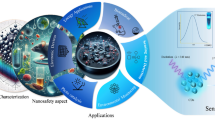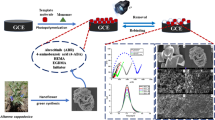Abstract
The authors describe an aptamer based assay for the model analyte diclofenac (DCF). It is based on the use of amino-functionalized magnetite and gold nanoparticles (Fe3O4/AuNPs) that were used to decorate carbon nanotubes (CNTs) to form a highly conductive film on the surface of a glassy carbon electrode. An amino-modified DNA capture probe (ssDNA1) was placed on the Fe3O4/AuNPs using glutaraldehyde as the linker. A DCF-specific aptamer (referred to as ssDNA2) acting as the detection probe was then attached to the surface of the modified electrode via hybridization. On addition of DCF, the conformation of the aptamer undergoes a change from a random coil structure to a rigid tertiary structure (like a pocket). This change can be traced by measuring the decrease of the current observed by differential pulse voltammetry using hexacyanoferrate as a redox probe, typically at a working voltage of 0.22 V vs. Ag/AgCl. The method has a 3.4 fM detection limit and two linear responses that cover the 0.01 to 1 pM and 10 to 1300 pM DCF concentration ranges.

(A) Schematic illustration of the preparation of amino-functionalized Fe3O4 NPs. (B) Schematic representation of different steps of aptasensor fabrication.







Similar content being viewed by others

References
Boelsterli UA (2013a) Mechanisms underlying the hepatotoxicity of nonsteroidal anti inflammatory drugs. Drug induced liver disease. 3rd ed. Elsevier. p 343–367. doi:10.2165/00002018-200225090-00003
Sein MM, Zedda M, Tuerk J, Schmidt TC, Golloch A, Sonntag CV (2008) Oxidation of diclofenac with ozone in aqueous solution. Environ Sci Technol 42:6656–6662. doi:10.1021/es8008612
Labbe G, Pessayre D, Fromenty B (2008) Drug-induced liver injury through mitochondrial dysfunction mechanisms and detection during preclinical safety studies. Fundam Clin Pharmacol 22:335–353. doi:10.1111/j.1472-8206.2008.00608.x
Soares ME, Seabra V, Bastos MDA (1992) Comparative study of different extractive procedures to quantify morphine in urine by HPLC-UV. J Liq Chromatogr 15:1533–1541. doi:10.1080/10826079208018306
Zhang XX, Li J, Gao J, Sun L, Chang WB (2000) Determination of morphine by capillary electrophoresis immunoassay in thermally reversible hydrogel-modified buffer and laser-induced fluorescence detection. J Chromatogr A 895:1–7. doi:10.1016/S0021-9673(00)00590-2
Agrawal YK, Shivramchandra K (1991) Visible spectrophotometric method for determination of diclofenac sodium. J Pharm Biomed Anal 9:97–100. doi:10.1016/0039-9140(94)00224-G
Abdel-Hamid ME, Novotny L, Hamza HJ (2001) Determination of diclofenac sodium, flufenamic acid, indomethacin and ketoprofen by LC-APCI-MS. J Pharm Biomed Anal 24:587–594. doi:10.1016/S0731-7085(00)00444-1
Xu MT, Chen LF, Song JF (2004) Polarographic behaviors of diclofenac sodium in the presence of dissolved oxygen and its analytical application. Anal Biochem 329:21–27. doi:10.1016/j.ab.2003.12.033
Bock LC, Griffin LC, Latham JA, Vermaas EH, Toole JJ (1992) Selection of single-stranded DNA molecules that bind and inhibit human thrombin. Nature 355:564–566. doi:10.1038/355564a0
Ho MY, Souza N, Migliorato P (2012) Electrochemical aptamer-based sandwich assays for the detection of explosives. Anal Chem 84:4245–4247. doi:10.1021/ac300606n
Xu Y, Yang L, Ye XY, He PG, Fang YZ (2006) Anaptamer-based protein biosensor by detecting the amplified impedance signal. Electroanalysis 18:1449–1456. doi:10.1002/elan.200603566
Huang HP, Zhu JJ (2009) DNA aptamer-based QDs electrochemiluminescence biosensor for the detection of thrombin. Biosens Bioelectron 25:927–930. doi:10.1016/j.bios.2009.08.008
Wang J, Jiang YX, Zhou CS, Fang XH (2005) Aptamer-based assay using aluminescent light switching complex. Anal Chem 77:3542–3546. doi:10.1021/ac050165w
Zhao Q, Li XF, Shao YH, Le XC (2008) Aptamer-based affinity chromatographic assaysforthrombin. Anal Chem 80:7586–7593. doi:10.1021/ac801206s
Li L, Yang F, Yang XR (2009) Electrochemical luminescence detection based on ruthe- nium(II) tris (bipyridine) immobilized in sulfonic-functionalised titanianano-particles by ion exchange strategy. Analyst 134:2100–2105. doi:10.1039/B903434J
Du X, Wang C, Chen M, Jiao Y, Wang J (2009) Electrochemical performances of nanoparticle Fe3O4/activated carbon supercapacitor using KOH electrolyte solution. J Phys Chem C 113:2643–2646. doi:10.1021/jp8088269
Cao DF, Hu NF (2006) Direct electron transfer between hemoglobin and pyrolytic graphite electrodes enhanced by Fe3O4 nanoparticles in their layer-by-layer self-assembly films. Biophys Chem 121:209–217. doi:10.1016/j.bpc.2005.11.003
Tang DP, Tang J, Su BL, Chen GN (2011) Gold nanoparticles-decorated amine-terminated poly(amidoamine) dendrimer for sensitive electrochemical immunoassay of brevetoxins in food samples. Biosens Bioelectron 26:2090–2096. doi:10.1016/j.bios.2010.09.012
Sun J, Zhou SB, Hou P, Yang Y, Weng J, Li XH, Li MY (2007) Synthesis and characterization of biocompatible Fe3O4 nanoparticles. J Biomed Mater Res A 80:333–341. doi:10.1002/jbm.a.30909
Peng D, Liang RP, Huang H, Qiu JD (2016) Electrochemical immunosensor for carcinoembryonic antigen based on signal amplification strategy of graphene and Fe3O4/au NPs. J Electroanal Chem 761:112–117. doi:10.1016/j.jelechem.2015.12.014
Kang X, Mai Z, Zou X, Cai P, Mo J (2007) A novel glucose biosensor based on immobilization of glucose oxidase in chitosan on a glassy carbon electrode modified with gold–platinum alloy nanoparticles/multiwall carbon nanotubes. Anal Biochem 369:71–79. doi:10.1016/j.ab.2007.07.005
Farid AF, Shah K, Wan AIZ, Shah MR (2016) Triazole-based highly selective supramolecular sensor for the detection of diclofenac in real samples. Ecotoxicol Environ Saf 129:103–108. doi:10.1016/j.ecoenv.2016.03.017
Xiao P, Weibel N, Dudal Y, Corvini PH, Shahgaldian P (2015) A cyclodextrin-based polymer for sensing diclofenac in water. J Hazard Mater 299:412–416. doi:10.1016/j.jhazmat.2015.06.047
Derikvand H, Roushani M, Abbasi AR, Derikvand Z, Azadbakht A (2016) Design of folding-based impedimetric aptasensor for determination of the nonsteroidal anti-inflammatory drug. Anal Biochem 513:77–86
karuppiah C, Cheemalapati S, Chen SM, Palanisamy S (2015) Carboxyl-functionalized graphene oxide-modified electrode for the electrochemical determination of nonsteroidal anti-inflammatory drug diclofenac. Ionics 21:231–238. doi:10.1007/s11581-014-1161-9
Oliveira MC, Bindewald EH, Marcolino LH, Bergaminim MF (2014) Potentiometric determination of diclofenac using an ion-selective electrode prepared from polypyrrole films. J Electroanal Chem 732:11–16. doi:10.1016/j.jelechem.2014.08.006
Afkhami A, Bahiraei A, Madrakian T (2016) Gold nanoparticle/multi-walled carbon nanotube modified glassy carbon electrode as a sensitive voltammetric sensor for the determination of diclofenac sodium. Mater Sci Eng C 59:168–176. doi:10.1016/j.msec.2015.09.097
Basiri F, Taei M (2017) Application of spinel-structured MgFe2O4 nanoparticles for simultaneous electrochemical determination diclofenac and morphine. Microchim Acta 184:155–162. doi:10.1007/s00604-016-1995-0
Arvand M, Hassannezhad M (2015) Square wave voltammetric determination of uric acid and diclofenac on multi-walled carbon nanotubes decorated with magnetic core-shell Fe3O4@SiO2 nanoparticles as an enhanced sensing interface. Ionics 21:3245–3256. doi:10.1007/s11581-015-1514-z
Wang C, Qian J, Wang K, Yang X, Liu Q, Hao N, Wang C, Dong X, Huang X (2016) Colorimetric aptasensing of ochratoxin a using au@Fe3O4 nanoparticles as signal indicator and magnetic separator. Biosens Bioelectron 77:1183–1191. doi:10.1016/j.bios.2015.11.004
Wang J (2005) Carbon-nanotube based electrochemical biosensors. A Review Electroanalysis 17:7–14. doi:10.1002/elan.200403113
Acknowledgements
The authors gratefully acknowledge the support of this work by the Khorramabad Branch, Islamic Azad University for financial support.
Author information
Authors and Affiliations
Corresponding author
Ethics declarations
The author(s) declare that they have no competing interests.
Electronic supplementary material
ESM 1
(DOCX 1.16 mb)
Rights and permissions
About this article
Cite this article
Azadbakht, A., Beirnvand, S. Voltammetric aptamer-based switch probes for sensing diclofenac using a glassy carbon electrode modified with a composite prepared from gold nanoparticles, carbon nanotubes and amino-functionalized Fe3O4 nanoparticles. Microchim Acta 184, 2825–2835 (2017). https://doi.org/10.1007/s00604-017-2285-1
Received:
Accepted:
Published:
Issue Date:
DOI: https://doi.org/10.1007/s00604-017-2285-1



